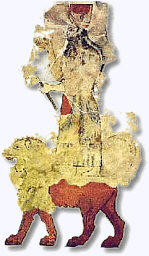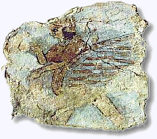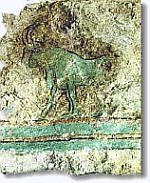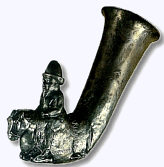The First Empires
Nairi and Urartu
Tour Armenia
NAIRI URARTU THE SCYTHIANS AND URARTU'S FALL
Map of Nairi and Urartu
Nairi
Also beginning about 2000 BC, the Assyrians used the term “People of the Nairi” to describe the same area. The territory and people both were called Nairi, but the word meant country or land of Rivers, and contemporary Assyrian accounts describe about 60 different tribes and small kingdoms and about 100 cities included in this land.
The “people” in this description were an alliance of tribes led by a dominant tribe, the Nairi. They are by now more than tribes; they are city-states in a common alliance. The Nairi alliance was based around Lake Van, which together with the Ararat Valley has the most fertile land in Western Asia, as well as the largest mineral deposits in Asia Minor and Mesopotamia.
About the word Nairi: The Armenian letter “i” (sounds like “ee”) can be traced to 15th c. BC inscriptions for water. Both the Nairi and Haius used this sound/symbol, as did the Assyrians. Thus, Nair- land, and i = water/rivers. The land of rivers north of Mesopotamia is that between the Euphrates and the Tigris, which flow from tributaries and sources above and below Mount Ararat. Ararat was already known as the mountain of the gods, and the territory was one of the trade routes from Central Asia and beyond.
The Nairi were considered a force strong enough to tackle both the Assyrians and Hittites, and populated a large territory rich in resources. They were attacked by King Tukulti-Ninutra I, and inscriptions at the Assyrian palace at Assur tell how 43 kings of the lands of Nairi rose up against the Assyrians, were defeated and brought to Assur in chains. The lands offered ransom to the king, tribute was extracted from them, and a new honor was added to the official style of the Assyrian king, “king of the lands of Nairi”.
The Nairi continued to resist Assyrian domination, and a second campaign by the Assyrian king Tiglath-Pileser I (1126-1090 BC) invaded the whole of the western part of the Armenian Plateau from North to South. The Assyrians penetrated into enemy territory to a depth of more than 300 miles. Assyrian annals describe the campaign in part, “…Sixty kings of the lands of Nairi, together with those who came to their aid, did I drive with my spear as far as the upper seas (the Black Sea). I captured their great cities, I carried off their riches and their spoils, I gave their dwellings to flames…All the kings of Nairi did I capture alive. But to all these kings I showed mercy…freeing them from their bonds of captivity…” There is no mention in the campaign of the areas around Lake Van, suggesting the Assyrians deliberately avoided the area occupied by the most powerful alliance of tribes.
The Assyrians never succeeded in completely subjugating the people of Nairi, but within 200 years its influence waned through the rise of a related tribe, the Urartu. This early slave-holding state first occupied the territories lying around Lake Van, on the Eastern Shore of which lay its capital, Tushpa (present town of Van). This is the same territory inhabited by the Nairi. As the Urartian kingdom rose to become one of the greatest regional powers in the region, the Nairi gradually disappeared within the limits of the country of Khubushkia, south of Lake van on the banks of the river Bokhtan-su, though they continued to be mentioned by Assyrian kings until the 8th c BC.
 Urartu Urartu
As early as the reign of the Assyrian king Shalmanaser I (1280-1266 BC), the first mention of Urartu is made, under the name “Uruatri”. Shalmanaser I’s texts describe a campaign against 8 countries collectively called the Uruatri. The extent of the country is not described, but it is likely other tribes living in the area around Van were included in the alliance, since the Assyrian name Uruatri had no ethnic significance but was probably a descriptive term (perhaps meaning “the mountainous country”). In texts written in the name of Shalmanaser I’s son, King Tukulti-Ninutra I, the tribes are referred to as the Nairi.
In the 11th c. BC Assyrian annals return to the name Uruatri or Uruartu, while in others both Uruatri and Nairi are used interchangeably. Dominant tribes were absorbing city-states, forming more than an alliance, they were becoming kingdoms, and through the Urartians, an empire.
By the 11th c BC, the Nairi tribe was usurped by the Urartians for hegemony in the region, and Assyrian cuneiform from this period record the first mention of Urartu as a strong power. The Assyrians went into almost 200 years of decline, allowing the alliance in the Armenian Plateau to develop and expand its influence. Hurrian influence in design and weapons continued, but gradually the Urartu tribe began to absorb Assyrian influences, including the use of cuneiform to replace pictogram writing. By the 9th c. BC the Urartu kingdom had established its regional power far beyond its capital at Tushpa (present day Van), invading Mesopotamia, and unifying the tribes in the Armenian plateau into one centralized state. The Urartians consistently cut Assyria from the trade routes to the Mediterranean, and enjoyed a monopoly on commerce between Asia and the West. The Urartians called their country Biainili (the name Urartu comes from the Assyrian language).
Urartu's Kings
Urartu was a remarkably developed culture that had extensive contacts with the major empires of the Ancient world stretching between the Mediterranean and India, and rivaled them for trade, military and cultural hegemony. Urartian timber was shipped to Egypt, its metal forges were used to produce iron weapons and tools, and its development of irrigation created vast agricultural tracts. They worshipped a pantheon of gods which closely resembled those in other empires, and their temple architecture show a similarity to that discovered in Ur (ca. 3500-2000 BC) and Babylon. It is known that when the Assyrian king Shargun II built Dur-Sharukin, he incorporated details from Urartian secular design schemes into his throne room. Frescoes found in the excavation of Erebuni in Yerevan are virtually identical to those later used by the Assyrians.
 The Urartians had a centralized government, led by a king, and were the first ancestral Armenians to successfully bind a federation of tribes into a large empire. Often at odds with the Assyrians, their history parallels the rise and fall of the Babylonian and Assyrian empires, and as an empire they were weakened along with the Assyrians from extensive warfare. Urartu was dealt a death blow in the 6th c. BC by first the Medians, and then the Achaemenid Empire (under Cyrus, Xerxes and Darius). At their height in the 8th c BC, they were strong enough to usurp Assyrian provinces and threaten her trade routes, and they invaded Babylon, going as far as the river Diala. The Urartians had a centralized government, led by a king, and were the first ancestral Armenians to successfully bind a federation of tribes into a large empire. Often at odds with the Assyrians, their history parallels the rise and fall of the Babylonian and Assyrian empires, and as an empire they were weakened along with the Assyrians from extensive warfare. Urartu was dealt a death blow in the 6th c. BC by first the Medians, and then the Achaemenid Empire (under Cyrus, Xerxes and Darius). At their height in the 8th c BC, they were strong enough to usurp Assyrian provinces and threaten her trade routes, and they invaded Babylon, going as far as the river Diala.
The entire history of Urartu is one of subjugation, attack and warfare. One the earliest of the Urartu kings is Ishpuinis (Ispuinis), who was successful enough with the Assyrians in warfare he began to assume titles of ever-increasing pomposity and glory. From “Ruler of Tushpa”, he soon added the titles, “King of the Land of Nairi”, “Great King”, Powerful King” and King of the Universe”. Ishpuinis succeeded in stretching the empire close to the edge of present day Armenia, along the Arax River, but was repelled by local tribes. Contemporary accounts show a series of attacks and counter-attacks between the Urartians and local kingdoms. At the same time, they were repelling repeated Assyrian attacks, and had so grown in wealth and military importance, that other tribes in the now “Nairi-Urartu” federation began to organize their own attacks against the new empire.
The first wave of warfare between the two great powers occurred during the reign of Shalmanaser III (860-825 BC), who had reformed the Assyrian empire and brought it out of decline. Shalmanaser III achieved success in the first three years of his reign, profusely recorded on bronze gates uncovered from the ancient Assyrian city of Imgur-Emil southeast of Ninevah. The bronze gates record Shalmanaser III’s continual wars with the Urartians.
Beginning with campaigns against the Urartu King Aramu, which destroyed several Urartian cities, the Assyrians never succeeded in reaching the heart of the kingdom, and successive campaigns invaded more and more peripheral areas of the country. By the end of Shalmanaser III’s reign, the bronze gates record no victories and hint at defeat at the hands of a new Urartu king Siduri (Sarduri). Sarduri was so confident in his power he had a erected massive wall at Tushpa, where inscriptions were carved in Assyrian and Urartian giving himself the titles “the magnificent king, the mighty king, king of the universe, king of the land of Nairi, a king having none equal to him, a shepherd to be wondered at, fearing no battle, a king who humbled those who would not submit to his authority.” No problem with self-esteem there.
The rise of the empire of Urartu is centered around three kings: Menuas, Argishti and Sardur I. Menuas in particular established the outlines of the empire, and organized the centralized administrative structure that enabled his son Argishti and grandson Sardur II to extend the empire to its furthest reaches. During his reign Menuas reached the northern spurs of Mount Ararat and reached the banks of the Arax River. He established a stronghold named Menuakhnili (starting an Urartian tradition of naming cities after its kings) in the environs of the present day village Tashburun. Menuas spent much of his efforts in internal organization of the empire, and most likely because of this Assyrian cuneiform do mention him. Urartian cuneiform shows that Menuas fortified the citadel of Tushpa and established cities and strongholds throughout the empire. The fortified cities (and their citadels) he built were built in such a way that communications between even the farthest reaches of the empire and Tushpa could raise an invasion force within a matter of hours. Of particular note, Menuas developed extensive irrigation within the Urartian Empire, some of which are still operating. Of these, the mistakenly called Shamiram (or Semiramis) canal was built during the reign of Menuas, and still supplies water to the region of Van.
 The wars between Urartu and Assyria accelerated during the early years of the reign of Argishti I. Though Menuas had an older son, Inushpuah, he did not succeed to the throne. Historians believe he became head priest of Khaldi (the chief god in the Urartian pantheon) at Musasir, which was the religious center for the country. Argishti, Menua’s younger son, did succeed to the throne in 786 BC, and was immediately embroiled in war with Assyria. Assyria--which had been weakened by earlier struggles-- suddenly began to expand its empire, and had particular eyes on the rich mining resources in the Armenian Plateau. The wars between Urartu and Assyria accelerated during the early years of the reign of Argishti I. Though Menuas had an older son, Inushpuah, he did not succeed to the throne. Historians believe he became head priest of Khaldi (the chief god in the Urartian pantheon) at Musasir, which was the religious center for the country. Argishti, Menua’s younger son, did succeed to the throne in 786 BC, and was immediately embroiled in war with Assyria. Assyria--which had been weakened by earlier struggles-- suddenly began to expand its empire, and had particular eyes on the rich mining resources in the Armenian Plateau.
The attacks against Urartu were a tactical error. Allowing Assyrians to cross the border on the Southern side, Argishti quickly consolidated early gains made against the invading army by outflanking the Assyrians in their provinces, through which her trade routes stretched. Pursuing Assyria on the south and east, his army conquered the countries of Melitanuh and Komaguenuh and invaded Babylon itself (by this time a possession of the Assyrians), reaching as far as the river Diala. Argishti succeeded in checking Assyria’s northern expansion for 50 years. One of the greatest generals at the time, the Assyrian Turtan Shamsheluh faced his only defeats by the Urartians. An inscription found at Tel-Borsippa shows a frustrated Shamsheluh frankly admitting who was the better general: Argishti “…whose name is as terrible as a dreadful storm, whose might is immeasurable, who cannot be compared with any one of the previous kings…”
Taking advantage of the fulcrum Menuas established at Menuakhnili, Argishti I crossed the Arax River and penetrated the Ararat Plain. He and his son, Sardur I expanded the empire as far as both shores of Lake Sevan, up to the edges of modern Georgia, incorporating most of the territory of the current Republic into its reaches. He ordered the building of several key outposts, among them Erebuni in 782 BC, which is the beginning of Yerevan’s history, and Argishitinili (present day Armavir). Erebuni was established in the foothill area on the edge of the Ararat Valley and served as a base for the Urartian advance into the area around Lake Sevan, a mountainous region, rich with cattle, occupied by tribes with Hurrian roots. The citadel of Erebuni contained a royal palace, a temple and storerooms. In the year before, campaigns in Northern Syria conquered the kingdoms of Hatti and Melita, and 6,600 prisoners captured in those wars were forced to build and settle the new city at Erebuni. Cuneiform at Erebuni proclaimed Argishti’s power, building a city “to declare the might of the land of Biaini and hold her enemies in awe”. Six year’s later Argishti established a new city in the Ararat Valley, calling it Argishitinili (“built by Argishti”). The city encompassed the hills around present day Armavir, with cyclopic walls reinforced by towers, within which were temples, storerooms and in the citadel, a new palace. Inscriptions found at the site bear witness to the importance of the city as an administrative and religious center, while Erebuni was used primarily as a military fortress.
By the end of Argishti I’s reign, in the middle of the 8th c. BC, Urartu was at the zenith of its power. It’s authority stretched between the Transcaucasus, Lake Urmia in present-day Iran, and well into the Hittite territory in the west. Northern Syria was dependent on Urartu, which now controlled the main trade routes to western Asia. Urartu barred Assyrian expansion into Asia Minor, and its culture had begun to penetrate into the Mediterranean area and the interior of Asia Minor. Urartian artifacts and design were used not only on mainland Greece but also as far away as Italy.
Argishti I’s son, Sarduri II, inherited a prosperous and flourishing kingdom. He continued his father’s external policies and strengthened the existing administration and economic centers. At the citadel of Tushpa, Sarduri II set up two stelae recording the annals of his reign. On one, where he recorded his successful campaigns against the Assyrians, information about the land of Armeh is included. The Armeh, in the upper Tigris Valley, became the nucleus of an alliance of tribes later called the Armenians. Sarduri II records successful campaigns and Urartu authority extending to the north of the Arax River and around Lake Urmia.
Sarduri’s reign, however, coincided with another revival of Assyria, under Tiglath-Pileser III in 745 BC. The Assyrians retook territories in Northern Syria held by Urartu, but did not cross the country’s borders until 735 BC, where he went as far as Tushpa, laying siege to the capital. The blow to the Urartu kingdom weakened its power and Sarduri spent the rest of his reign re-conquering territories his father Argishti had captured.
 The Scythians and Urartu’s Fall The Scythians and Urartu’s Fall
By the reign of Rusa I beginning in 735 BC, Urartu was in continual threat of attack from Assyria in the South, internal dissension among feudal states in the kingdom, and a new threat from migrating Cimmerians from the North. He erected two fortresses on Lake Sevan, one west of the lake by Gavar, and the other to the south at Teishebaini (Karmir Blur in Yerevan).
In 722 BC, the son of Tiglath-Pileser, Sargon, overthrew his brother and seized the Assyrian throne (is this reading like a Shakespeare History, or what?). He immediately set about conquering the vassal states under Egypt in Syria and Palestine, the kingdom of Babylon, and to the north, Urartu. He defeated the Egyptian Pharaoh Shabaka, and then set out to destroy Urartu. Beginning in 714 BC, Sargon first attacked the area around Lake Urmia. An attempt by Rusa to move to the rear of the Assyrian army and attack was thwarted when the Assyrians received a tip from a spy in the Urartu camp, and completely annihilated the Urartu forces in a mountain gorge. Sargon then moved on to central Urartu, bypassing Tushpa to attack the city of Musasir.
A small sample of the enormous wealth in Urartu can be found in a contemporary accounting ledger of the treasures the Assyrian King Sargon (reigned 722-704 BC) took when he capture Musasir in 713 BC.
In the palace storerooms (in Musasir, an outpost of Urartu by Lake Urmia), The Assyrians found more than a ton of gold (34 talents, 18 minas); nearly five tons of silver (167 talents, ½ mina); more than four hundred precious objects, broken into 44 types, including gold and silver swords and daggers, silver cups, cups with gold handles…
In the temple of Khaldi (the primary Urartian deity), the Assyrians found a large amount of gold, another five tons of silver, and more than 109 tons of bronze ingots. Among the primary objects listed were:
“6 gold shields, flame-red in color, which hung in his chamber on the right and left sides and shone with dazzling brightness; in the middle of them are the heads of dogs with bared teeth; they weighed 5 talents and 12 minas (about 140 lbs.)… one gold door bolt in the shape of a man’s hand, the fastening on the door in the shape of a monster; 2 gold keys in the shape of lamassus (winged demons) wearing tiaras… weighed 2 talents and 12 minas (about 145 lbs.) of gold…25,212 brazen (bronze) shields both heavy and light…; 1,514 brazen javelins both heavy and light; heavy brass spear heads…; brass lances with brass supports; 305,412 swords…; 1 large sword, a weapon worn at his waist, to the making of which went 26 minas and 3 su (about 30 lbs.) of gold; 96 silver javelins… silver bows and silver spears, inlaid with gold and mounted; 12 heavy silver shields, the bosses of which are made in the form of the heads of monsters, lions and wild bulls…; 33 silver chariots.” The ledger continues with 393 silver cups, 2 horns set in gold rims, 1 gold signet ring with seal inlaid with precious gems, 9 fabrics for the temple deity, embroidered with golden discs, 1 bed of ivory, 1 silver couch framed in gold and decorated with gems, 139 batons of ivory, 10 tables of boxwood, and chairs of ebony and boxwood set with gold and silver, 2 altars, 14 various stones for the ornament of the deity, precious stones belonging to the deity…”
The total ledger lists 61 different types of items taken and a total of 335,000 objects in all. Mind, this was not the main capital, but an outpost of the kingdom. Even though a partial listing, it is staggering in its proportions and amount of wealth. Very few of the items were manufactured outside of Urartu, which gives a good idea of the enormous wealth within the kingdom, and why it was envied by surrounding empires.
The destruction of Musasir had a devastating effect on Urartu. The Assyrians record that upon hearing of the destruction of the city, and the theft of the icon of supreme god Khaldi, Rusa ended his life with a dagger.
Recovery and Defeat
The Urartians recovered under the reign of Rusa’s son, Argishti II, and Assyria’s conflicts with Egypt, Babylon and Syria, as well as the death of Sargon, allowed the empire to recover and rally. The Urartians rebuilt Musasir and other cities destroyed in the campaign, and re-conquered most of their empire. The country along the Araxes was developed - something which is proved by archaeologists, who have discovered that there are far more seventh than eighth century settlements.
By the reign of the Rusa II in the 7th c, the Urartians had recovered their position as a prominent power, re-establishing their influence over trade routes to the Mediterranean. Assyria faced threats by the Cimmerians and Scythians, who were entering into alliances with neighboring kingdoms, including the Urartu. Rusa II built a new capital called Rusahinili, which remained the capital of Urartu for 100 years, until the destruction of the empire.
In the 6th c. BC, Urartu and Assyria were both weakened by constant warfare. Having formed an alliance with Scythians that had migrated from the north, Urartu ended abruptly ca. 585 BC after the Medes--assisted by Scythians-- invaded and destroyed the capital of Tushpa. Remains of the Urartian Empire in Armenia include the citadels of Erebuni, Karmir Blur, Armavir (Argishitinili), and three fortified cities on Lake Sevan. Urartu occurred at the same time as the Doric invasion of Greece, Babylon, Assyria, the New Kingdom in Egypt, and the Chan dynasty in China.


 Top
Top

|
